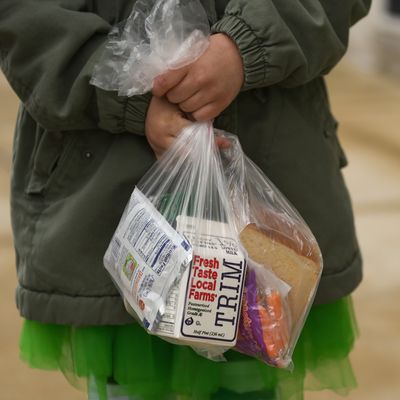
The COVID-19 pandemic is driving rates of child hunger to disturbing new heights, the Brookings Institution announced on Wednesday. A Brookings analysis of the COVID Impact Survey found that “nearly 23 percent of households said they lacked money to get enough food, compared with about 16 percent at the worst of the Great Recession,” the New York Times reported. Households with children are even in worse shape. Almost 35 percent said they did not have enough food, up from 21 percent during the recession.
“Looking over time, particularly to the relatively small increase in child food insecurity during the Great Recession, it is clear that young children are experiencing food insecurity to an extent unprecedented in modern times,” Lauren Bauer, the Brookings researcher, concluded. Analyzing further results from the Survey of Mothers with Young Children, Bauer also found that “that 40.9 percent of mothers with children ages 12 and under reported household food insecurity since the onset of the COVID-19 pandemic.” Since 2018, Bauer continued, the share of mothers with children under 12 who report “that the food that they bought did not last” has jumped by 170 percent.
Bauer’s findings illustrate a secondary human cost of the pandemic. The Labor Department will release new jobless numbers on Friday, and unemployment for April is expected to hit at least 15 percent. There are human stories behind the numbers and those photos of long lines for local food banks. Mothers can’t afford to buy enough food for their children, and it’s unclear when circumstances will improve.
The pandemic is a fast-moving force whose transformative qualities are evident, but not fully formed. When you’re in the middle of something unprecedented it can be difficult to tell where you’ll land once it’s over. But there are reasons to think that our post-pandemic future could be grim. Hunger in children can inflict long-lasting psychological damage and limit educational attainment, research has found. It can also make children more susceptible to physical illness. They may be more likely to develop chronic conditions like asthma, iron-deficiency anemia, and to have low bone density.
Meanwhile, solutions seem to be in short supply. Bauer’s research for Brookings should reinforce worries among the left that a one-time $1,200 check for the neediest individuals, or $2,400 for married couples, with an extra $500 tacked on for each child, won’t be enough to keep people fed. The economic downturn will last for months at a minimum. Increased unemployment benefits should help keep households afloat, but archaic state systems — some of them, like Florida’s, designed deliberately to keep applicants out — prevent parents from getting the help they need when they need it.
And as the Times notes, both major political parties are at odds over the future of the Supplemental Nutrition Assistance Program, or SNAP. The Trump administration has sought persistently to cut it, and while Congress did recently increase benefits for most SNAP recipients, that measure is temporary. Hungry families need more help, but after decades of bipartisan neglect, the American welfare state isn’t strong enough to support them.






























